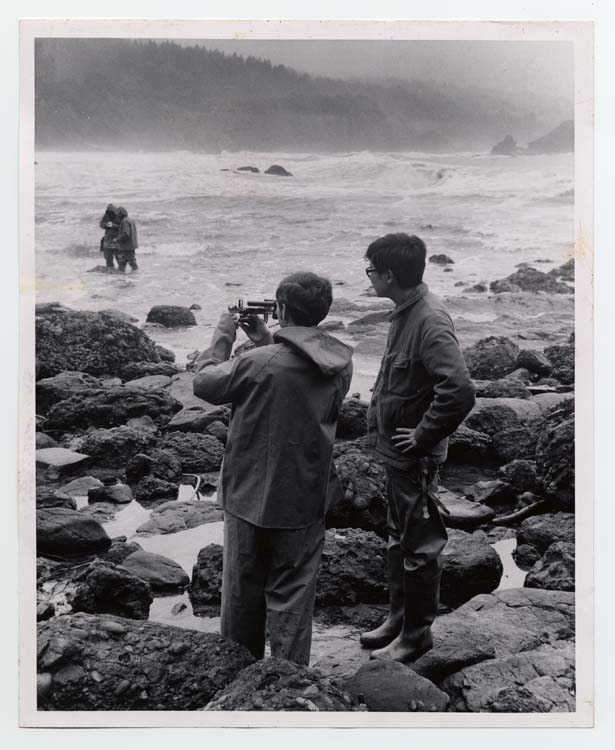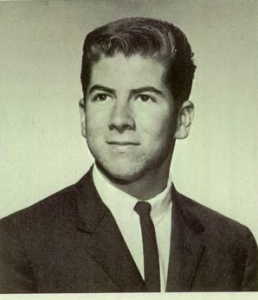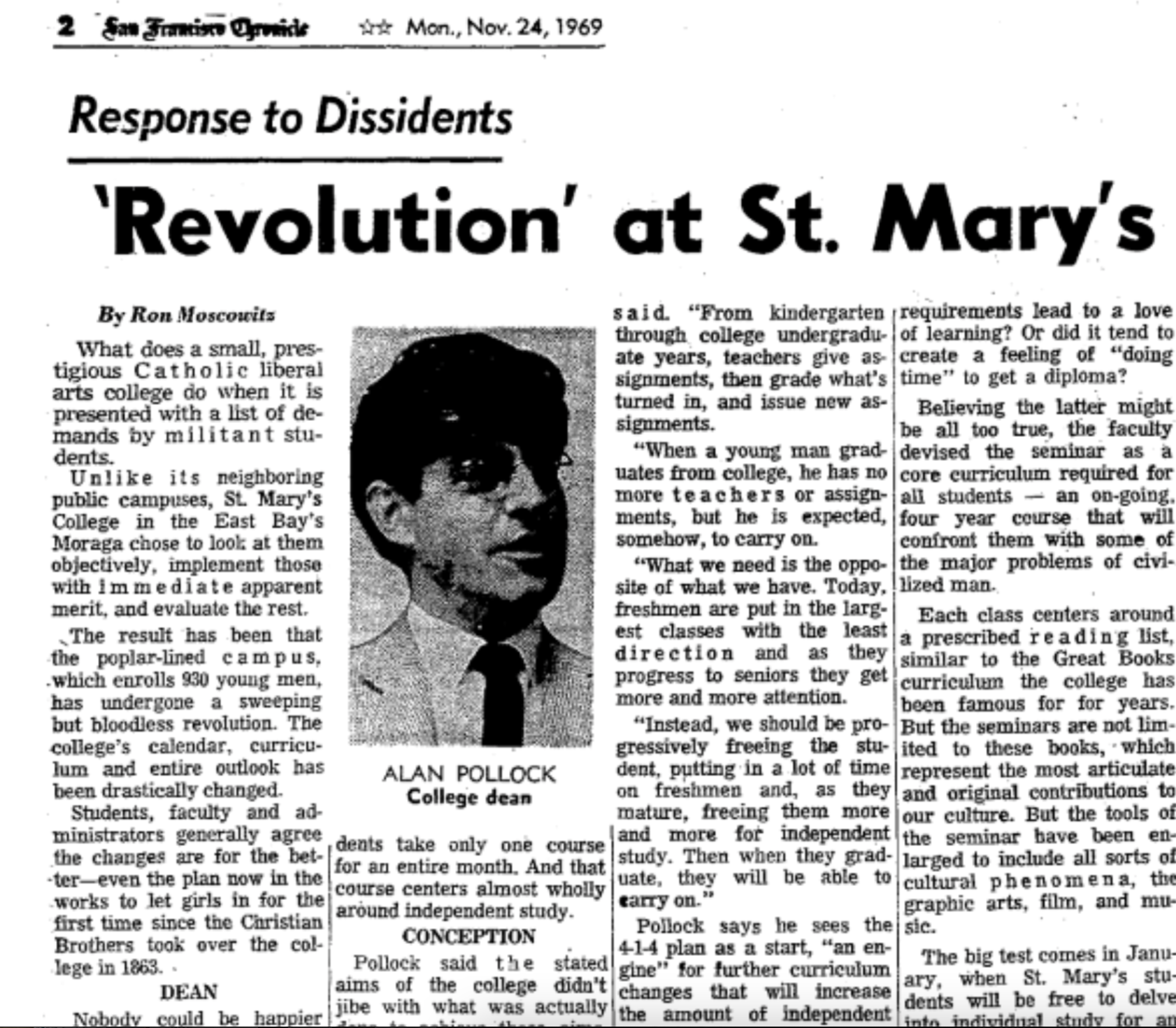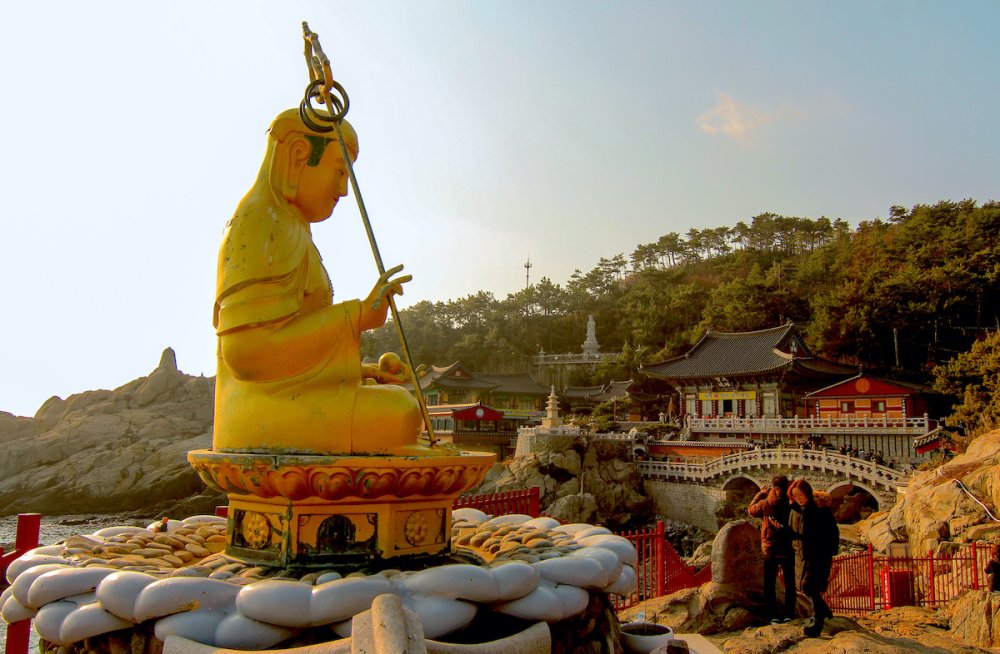Why Does Jan Term Exist? The Answer Will Surprise You.
In 1968, a year marked by protests and resistance, student activists revolutionized Saint Mary’s culture and curriculum. They also helped kickstart one of the College’s signature programs.
What is Jan Term? Ask any Saint Mary’s student, and you’ll probably get a similar answer: the unique opportunity to spend a month diving deep into one class, on campus or around the globe. Each January, students could find themselves drafting a romance novel, guiding a sled dog team through the wilds of Scandinavia, or brewing their own IPAs. (Our social media team recently asked students—and one dog—to define Jan Term. Hear their answers.)
Jan Term might well be Saint Mary’s most popular program; it’s certainly beloved by students, staff, and alumni alike. And yet, Gaels today may be unaware of how it became an annual tradition in the first place. In fact, if it weren’t for the concerted efforts of student activists over half a century ago, the College’s signature program might not exist at all.

The Moraga Manifesto
The year the seeds of Jan Term were planted, 1968, was one marked by student-led protests, in the Bay Area and throughout the world. From Los Angeles to Paris to Tokyo, students staged walk-outs and sit-ins; they opposed racial injustice, government overreach, and the mounting horrors of the Vietnam War.
As they pursued change, protestors also called for reform within their own schools. At neighboring UC Berkeley and San Francisco State University, students led one of the longest student protests in history—the Third World Liberation Front strikes—demanding their institutions acknowledge and teach the histories of people of color. Eventually, their demonstrations helped create the field of Ethnic Studies itself.
Only a few miles away, in Moraga, Saint Mary’s students were calling for some big changes of their own. They, too, were dissatisfied with a curriculum and culture they felt was more fitting for the 1860s than the 1960s, one that required undergraduates to take 17 (!) units of philosophy—possibly the highest requirement in the country—and limited their chances to explore topics outside their major.
“The opportunity for innovation and creativity is what snagged us.”
In the fall of 1968, student body president Daniel Whitehurst ’69 expressed these sentiments in a statement in The Collegiate, the Saint Mary's student newspaper. He envisioned a more relevant curriculum, one that allowed students to pursue “the great issues of mankind.”
“This is nothing revolutionary,” Whitehurst wrote. “These very ideas are stated in the St. Mary’s catalog [sic].”
Student action ramped up the following year, when a group of 100 or so students formed Students for Progressive Action Now, or SPAN, with Whitehurst as their leader. In February 1969, Whitehurst presented college administrators with a list of 27 reforms, later dubbed the “Moraga Manifesto.”

SPAN’s document was expansive, calling for the recruitment of more students of color, an overhaul of the required curriculum, and the admission of female students. The list also proposed a fundamental calendar reform: a shift from the two-semester system to a 4–1–4 calendar first pioneered by Florida Presbyterian College. This model allowed students a shorter term to focus on one class of their choosing.
What drew Whitehurst and SPAN to that system? “We thought, ‘Let’s clean up the number of classes that we have to take,’” he told me. “It seemed like everybody had seven classes they were taking each semester.”
But the other piece of it, Whitehurst said, was just how fun the new structure sounded. “Students could focus on something they wanted to do. They’d have the chance to do something off campus, maybe travel, maybe get involved in a project of some kind. I think the opportunity for innovation and creativity is what snagged us.”
A Peaceful Revolution
Student protests at San Francisco State led to police beating and arresting students, and in Berkeley, they led to tear gas and National Guard tanks barelling down Telegraph Avenue. At Saint Mary’s the student action never led to escalation.
That was intentional, Whitehurst said: “Back then, students elsewhere were making ‘demands.’ I think we couched things in terms of ‘proposals.’ We tried to make it a constructive rather than destructive kind of effort.”
Perhaps most remarkable of all: how quickly those proposals were accepted. Just a few short months after Whitehurst presented the Moraga Manifesto, the faculty voted to accept virtually all of the proposals. The hefty list of required liberal arts courses was out; Collegiate Seminars were in. Saint Mary’s was no longer the boy’s club it had been since 1863; women would be admitted in the fall of 1970. And, beginning the next academic year, students would now have a new 4–1–4 calendar with a January Term.
“Students, faculty, and administrators generally agree that the changes are for the better.”
—San Francisco Chronicle, November 1969
The speed of Saint Mary’s reforms caught the attention of the San Francisco Chronicle. “Unlike its neighboring public campuses,” the College had enacted a “sweeping but bloodless revolution,” the newspaper assessed in a November 1969 write-up. “Students, faculty, and administrators generally agree that the changes are for the better.”
The big test, the Chronicle noted, would come in January 1970, when students would embark on Jan Term for the first time: “Some will go to San Francisco investment houses; some will go to Napa to observe treatment of mental patients; a few will go to Europe to study anything from archaeology to education.”

A Legacy to Be Proud Of
While Whitehurst helped bring Jan Term into being— and along with it, Seminar and coeducation—he never got to experience the fruits of SPAN’s labors. He graduated in May of 1969 and was soon enrolled in law school at UC Berkeley. He went on to have a thriving career in politics, serving as Fresno’s mayor from 1977 to 1985.
Still, he is pleased with what SPAN was able to accomplish. “I’ve enjoyed watching the impact over the years, especially the introduction of women and Jan Term,” he says. “Of all we worked to get implemented, those really seem to have had the greatest positive impact.”
Whitehurst is also proud of how he and his fellow Gaels pushed for change. “It was all based on persuasion. And, fortunately, the College was receptive to persuasion. I think that's one feature that distinguished our little revolution from what was going on at a lot of other places.”
“It's gratifying to know we continue to offer students and faculty the opportunity to live out Jan Term’s original intent."
—Claire Williams, Interim Director of Jan Term
This year, Saint Mary’s celebrated its 53rd Jan Term since the Moraga Manifesto. After two years impacted by the pandemic, students had an enviable range of travel and on-campus courses to choose from. That opportunity for “creativity and innovation,” which first inspired Whitehurst and his peers in 1969, remains a hallmark of the Jan Term experience.

Claire Williams, the Interim Director of January Term, sees poignancy in the fact one of the College’s most popular programs exists because students pushed for it. But it doesn’t surprise her.
“Saint Mary's is first and foremost a student-centered institution,” Williams said. “It's gratifying to know we continue to offer students and faculty the opportunity to live out Jan Term’s original intent.
“That said, the Gaels of 1969 would likely never have imagined the courses we offer now: selfies, podcasts, video games, infinity stones, or green chemistry!"
So whether students are swinging lightsabers or snorkeling in Bali, they’re taking part in a tradition that Whitehurst and SPAN kicked off over 50 years ago. Here’s hoping for 50 more.
Hayden Royster is a Staff Writer with the Office of Marketing and Communications. Write him.
Learn more about Jan Term—and alumni, be sure to explore Jan Term in June!
Keep the tradition of Jan Term going strong: Make a gift to support Saint Mary’s students.